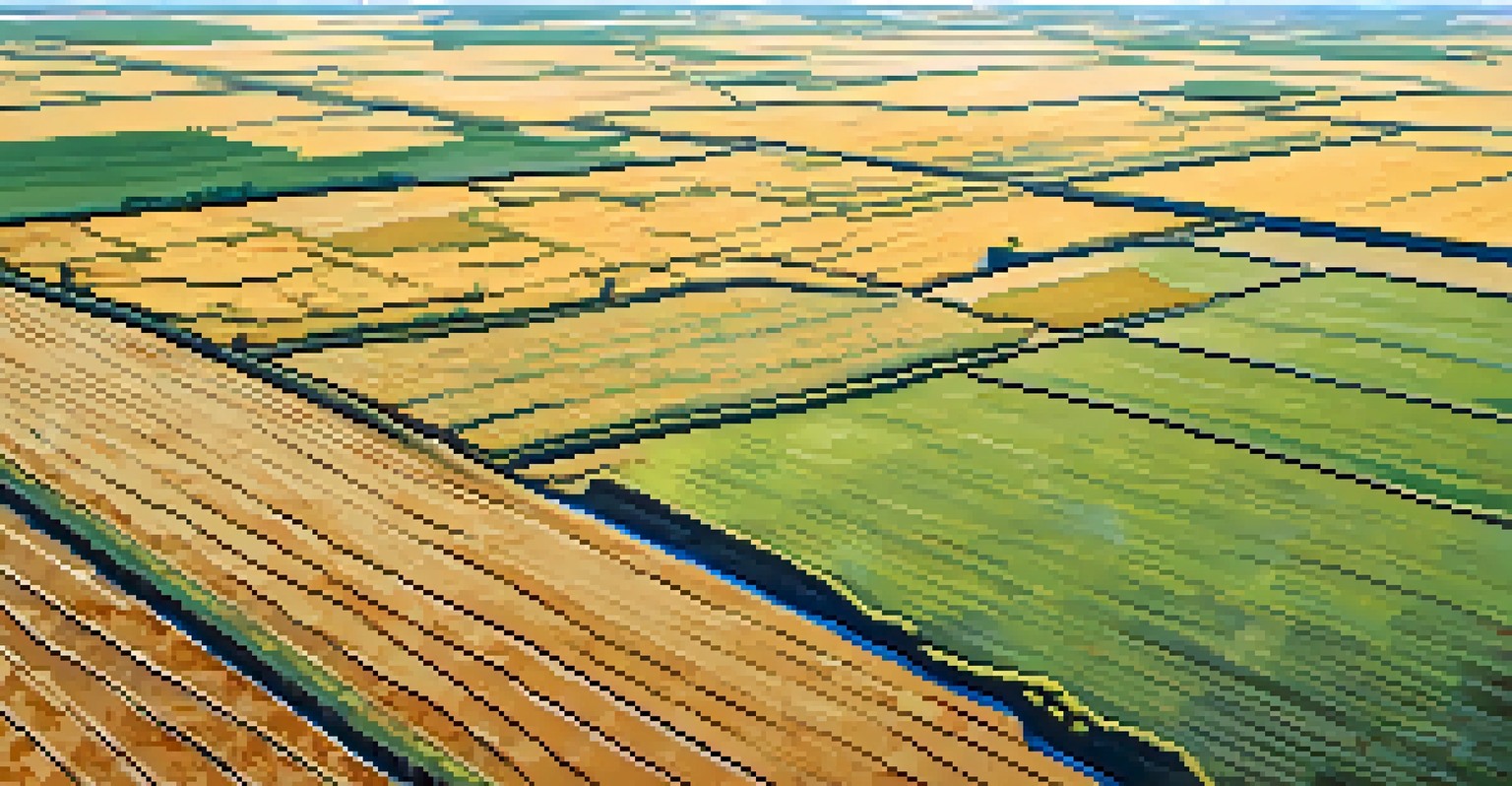Kansas Weather Extremes: Tornadoes, Droughts, and Flooding

Understanding Kansas Tornadoes and Their Frequency
Kansas is famously known as 'Tornado Alley,' a region that experiences a high frequency of tornadoes each spring. The unique geography, with flat plains meeting warm, moist air from the Gulf of Mexico, creates the perfect conditions for these violent storms. On average, Kansas witnesses around 50 tornadoes annually, making it one of the most tornado-prone states in the U.S.
In the midst of chaos, there is also opportunity.
The destructive power of tornadoes can be immense, with wind speeds reaching over 200 miles per hour in the most severe cases. Communities often face significant damage to homes, infrastructure, and agriculture, leading to long recovery periods. Understanding tornado patterns and preparation methods can help residents better protect themselves and their properties.
While tornadoes can strike at any time, they are most common between April and June. This time frame serves as a reminder for residents to stay informed and have emergency plans in place. By tuning into weather alerts and local news, Kansans can increase their chances of staying safe during these extreme weather events.
The Impact of Droughts in Kansas Agriculture
Droughts pose a significant challenge for Kansas, particularly for its agriculture-dependent economy. With vast stretches of farmland, the state relies heavily on consistent rainfall for crops like wheat, corn, and soybeans. When drought conditions prevail, farmers face reduced yields, which can lead to economic strain both locally and nationally.

During a drought, water conservation becomes essential. Farmers often resort to techniques like drip irrigation and crop rotation to maximize their water use and maintain crop health. However, these strategies can require significant investment and may not be feasible for every farmer, leading to disparities in the agricultural community.
Kansas Tornadoes: High Frequency
Kansas experiences around 50 tornadoes annually due to its unique geography, making it crucial for residents to stay informed and prepared.
Moreover, droughts can have a cascading effect on food prices and availability. As supply decreases, prices can increase, impacting consumers and food systems beyond Kansas. Understanding these impacts highlights the need for effective water management practices and innovative farming techniques to mitigate future drought effects.
Flooding: A Growing Concern for Kansas Residents
Flooding is another extreme weather phenomenon that Kansas residents must contend with, particularly during heavy rainfall or snowmelt. Rivers like the Kansas River and the Arkansas River can overflow their banks, leading to significant property damage and displacement. The increasing intensity of storms linked to climate change has made flooding an even more pressing issue in recent years.
The best way to predict the future is to create it.
Communities often implement flood control measures, such as levees and drainage systems, to manage this risk. However, these solutions are not foolproof and can require continuous maintenance and upgrades as weather patterns change. Residents are encouraged to stay informed about their local flood zones and to have a plan in place for evacuation if necessary.
Beyond immediate damage to homes and infrastructure, flooding can also affect local ecosystems and water quality. As floodwaters recede, they can leave behind debris and pollutants, impacting wildlife and drinking water supplies. This interconnectedness emphasizes the importance of comprehensive disaster preparedness and community resilience strategies.
The Cycle of Weather Extremes in Kansas
Kansas experiences a unique cycle of weather extremes, with periods of severe drought often followed by intense flooding. This cyclical pattern can pose challenges for residents and farmers alike, requiring them to adapt quickly to shifting conditions. Understanding this cycle can help communities better prepare for the unpredictable nature of Kansas weather.
For instance, after a drought, the sudden influx of rain can lead to flash floods, which can be particularly dangerous. This transition period underscores the importance of water management and conservation efforts, as communities must find a balance between harvesting rainwater and preventing runoff. Awareness and preparedness are key in navigating these changing conditions.
Droughts Challenge Kansas Agriculture
Droughts significantly impact Kansas's agriculture, leading to reduced crop yields and economic strain, highlighting the need for effective water management.
Moreover, the cycle of extremes can also influence local economies and infrastructure. As communities face the dual threats of drought and flooding, they may need to invest in more resilient systems that can withstand both. This shift not only enhances community safety but also promotes sustainable practices that benefit Kansas in the long term.
Climate Change and Its Effects on Kansas Weather
Climate change is increasingly impacting weather patterns in Kansas, leading to more frequent and severe weather events. As temperatures rise, the likelihood of extreme heat, drought, and intense storms also increases, challenging residents to adapt to these new realities. Understanding these changes is crucial for planning and preparedness efforts.
For instance, warmer temperatures can lead to prolonged droughts, which affect crop yields and water supply. Conversely, when storms do occur, they may be more intense, resulting in sudden flooding. This shift highlights the need for a proactive approach to climate resilience that includes sustainable farming practices and water conservation measures.
Additionally, public awareness and education about climate change's effects are essential for fostering community resilience. By engaging residents in discussions about climate adaptation strategies, Kansas can build a more informed and prepared populace ready to face these challenges head-on.
Preparing for Weather Extremes in Kansas
Preparation is key when it comes to facing the weather extremes that Kansas is known for. Residents are encouraged to create emergency plans that include communication strategies, evacuation routes, and emergency supply kits. These steps can make a significant difference in ensuring safety and minimizing panic during severe weather events.
Moreover, local governments and organizations often provide resources and training to help residents prepare for specific weather events, such as tornado drills or flood safety workshops. Engaging with these resources can empower individuals and families to take control of their safety and well-being. Community involvement can also amplify these efforts, as neighbors can support one another during challenging times.
Flooding Risks in Kansas
Increasing storm intensity linked to climate change has made flooding a growing concern for Kansas residents, necessitating comprehensive disaster preparedness.
Finally, investing in home safety measures can further enhance preparedness. This might include reinforcing structures against tornado winds, installing sump pumps for flooding, or creating rain gardens to manage runoff. By taking proactive measures, Kansans can mitigate risks associated with the state's extreme weather patterns.
The Role of Technology in Weather Forecasting
Advancements in technology have significantly improved weather forecasting and monitoring in Kansas. With tools like Doppler radar and satellite imagery, meteorologists can track storms and predict severe weather events more accurately. This real-time data plays a crucial role in helping communities prepare for and respond to extreme weather.
Additionally, mobile apps and weather alert systems have become essential resources for residents. These tools provide timely updates on weather conditions, allowing individuals to make informed decisions about their safety. The ability to receive alerts directly on smartphones means that residents can stay connected, even when they are on the go.

As technology continues to evolve, there’s potential for even greater advancements in weather prediction. Embracing these innovations can enhance Kansas's preparedness for tornadoes, floods, and droughts. By integrating technology into everyday life, residents can create a culture of safety and resilience amid the unpredictability of Kansas weather.